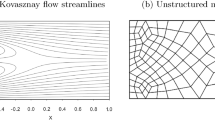Abstract
Ocean circulation models based on triangular C-grid discretization are frequently employed to simulate coastal ocean dynamics on unstructured meshes. It is shown that on time and space scales dominated by slow geostrophic dynamics, this discretization tends to exhibit checkerboard noise in the field of horizontal velocity divergence and vertical velocity, respectively. The noise is linked to the geometry of triangular C-grid and is amplified in regimes that are close to geostrophic balance through the particular structure of the Coriolis operator. It can be partly suppressed in some cases but remains a problem in a general case and makes the triangular C-grid a suboptimal choice for large-scale ocean modeling.




Similar content being viewed by others
Notes
The code can be supplied on request.
References
Casulli V, Walters RA (2000) An unstructured grid, three-dimensional model based on the shallow water equations. Int J Numer Methods Fluids 32:331–348
Fringer OB, Gerritsen M, Street RL (2006) An unstructured-grid, finite-volume, nonhydrostatic, parallel coastal ocean simulator. Ocean Model 14:139–173
Gassmann A (2010) C-grid discretization of the SWE in planar trivariate coordinate system. J Comput Phys (in press)
Hanert E (2004) Toward a finite element ocean circulation model. Ph.D. thesis, Université Catolique de Louvain, Belgium. Available online at http://sites.uclouvain.be/slim/assets/files/hanert_phd.pdf
Le Roux DY, Rostand V, Pouliot B (2007) Analysis of numerically induced oscillations in 2D finite-element shallow water models. Part I: inertia-gravity waves. SIAM J Sci Comput 29:331–360
Pedlosky J (1996) Ocean circulation theory. Springer, Berlin
Perot B (2000) Conservation properties of unstructured staggered mesh schemes. J Comput Phys 159:58–89
Rostand V, Le Roux DY, Carey G (2008) Kernel analysis of the discretized finite difference and finite element shallow-water models. SIAM J Sci Comput 31:531–556
Stuhne GR, Peltier WR (2006) A robust unstructured grid discretization for 3-dimensional hydrostatic flows in spherical geometry: a new numerical structure for ocean general circulation modeling. J Comput Phys 213:704–729
Stuhne GR, Peltier WR (2009) An unstructured C-grid based method for 3D global ocean dynamics: free-surface formulations and tidal test cases. Ocean Model 28:97–105
Walters RA, Hanert E, Pietrzak J, Le Roux DY (2009) Comparison of unstructured, staggered grid methods for the shallow water equations. Ocean Model 28:106–117
Acknowledgements
I am indebted to E. Hanert and A. Gassmann for their critical remarks on the earlier version of this work which led to substantial changes. The discussion with D. Le Roux was very helpful too.
Author information
Authors and Affiliations
Corresponding author
Additional information
Responsible Editor: Pierre Lermusiaux
Rights and permissions
About this article
Cite this article
Danilov, S. On utility of triangular C-grid type discretization for numerical modeling of large-scale ocean flows. Ocean Dynamics 60, 1361–1369 (2010). https://doi.org/10.1007/s10236-010-0339-6
Received:
Accepted:
Published:
Issue Date:
DOI: https://doi.org/10.1007/s10236-010-0339-6




